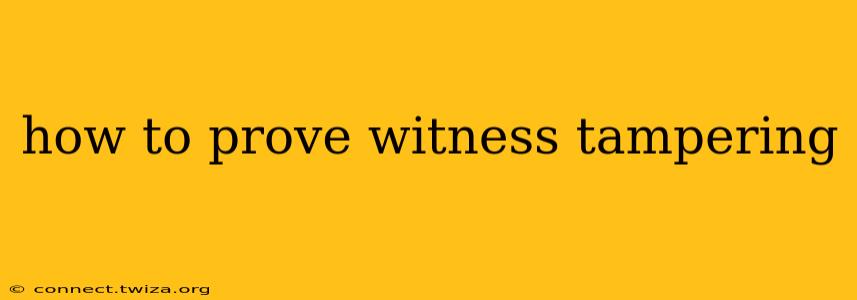How to Prove Witness Tampering: A Comprehensive Guide
Witness tampering, a serious offense carrying hefty penalties, involves any attempt to influence a witness's testimony or prevent them from cooperating with law enforcement or the courts. Proving it, however, requires meticulous evidence gathering and a clear understanding of the legal definition. This guide will delve into the strategies and evidence necessary to successfully prove witness tampering.
Understanding the Elements of Witness Tampering
To successfully prove witness tampering, you must demonstrate the following elements:
-
An intent to influence, delay, or prevent testimony: This isn't just about outright threats; it encompasses subtle coercion, bribery, intimidation, or even seemingly innocent actions aimed at changing a witness's account. The prosecution must prove that the accused intended to tamper with the witness, not just that they happened to interact with them.
-
A witness in a legal proceeding: This refers to anyone who has information relevant to an ongoing or anticipated legal case, whether civil or criminal.
-
An act taken to influence the witness: This is the crucial element requiring substantial evidence. This act can manifest in various forms, as detailed in the sections below.
Types of Evidence to Prove Witness Tampering
Proving witness tampering relies heavily on compelling evidence. The types of evidence often used include:
-
Direct Evidence: This is the most powerful type, such as a confession from the accused admitting to attempting to influence a witness. Recorded conversations (with proper legal authorization) are also potent direct evidence.
-
Circumstantial Evidence: This type of evidence doesn't directly prove the act but strongly suggests it. Examples include:
- Threats or intimidation: Written threats (emails, letters, texts), verbal threats witnessed by others, or even implied threats through actions can be used.
- Offers of bribes or rewards: Evidence of financial transactions, promises of gifts, or offers of employment in exchange for altering testimony.
- Attempts to influence witness memory: This could involve providing false information to the witness, trying to plant false memories, or suggesting what to say.
- Surveillance or stalking: Evidence of following the witness, monitoring their activities, or using technology to track their movements.
- Witness recantation: While not direct evidence of tampering, a sudden and unexplained change in a witness's testimony can be circumstantial evidence if accompanied by other suspicious activities.
- Witness disappearance or injury: If a witness disappears or suffers an injury following contact with the accused, this can raise suspicions of tampering.
Common Questions About Proving Witness Tampering
Here are some frequently asked questions about proving witness tampering:
What constitutes a "threat" in witness tampering cases?
A threat doesn't need to be explicit. It can be implied, veiled, or even communicated non-verbally. The key is that a reasonable person in the witness's position would interpret the communication as a threat to their safety, well-being, or livelihood if they testify truthfully. Factors considered include the relationship between the accused and the witness, the context of the communication, and the witness's perception of the threat.
Can I prove witness tampering without direct evidence?
Yes. While direct evidence is ideal, circumstantial evidence can be just as powerful if it creates a compelling narrative of the accused's intent to influence the witness. Multiple pieces of circumstantial evidence working together can paint a convincing picture. The prosecution will often build their case on a combination of direct and circumstantial evidence.
What if the witness refuses to cooperate?
A witness's reluctance to cooperate can be a challenge but doesn't automatically invalidate a tampering case. The prosecution will need to establish that the accused's actions caused the witness's reluctance, and may present other evidence to corroborate the witness’s initial statement.
What are the penalties for witness tampering?
Penalties for witness tampering vary depending on the jurisdiction and the specifics of the case, but they are generally severe and can include significant prison sentences and fines.
How can I protect myself from being a victim of witness tampering?
Protecting yourself from witness tampering requires proactive measures, such as keeping records of all communications, reporting suspicious activity to law enforcement immediately, and cooperating fully with investigators. Law enforcement agencies can also offer witness protection programs in appropriate cases.
Conclusion
Proving witness tampering requires a multi-faceted approach involving careful evidence collection, meticulous documentation, and a strong understanding of the legal elements involved. The strength of your case hinges on the quality and quantity of evidence presented. If you suspect witness tampering, seeking legal counsel is crucial to navigate the complexities of the legal process and protect your rights.
